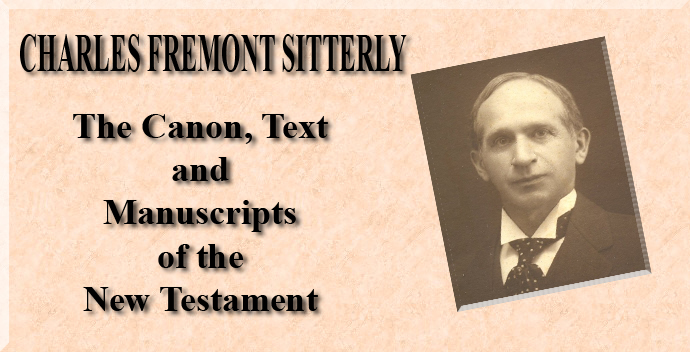
The Canon, Text, and Manuscripts of the New Testament
By Charles Fremont Sitterly
PART III - THE MANUSCRIPTS OF THE GREEK NEW TESTAMENT
Chapter 2
The Instruments with which the Manuscripts were Written
|
Section I. Pens Foe writing upon papyrus the instrument commonly used was the hollow reed pen (κάλαμος, 3 John 13). It was cut to a point and split like a quill even in the earliest times. A fine pointed brush (κονόἰλιον) was not infrequently used, especially in Egypt, both for writing and illuminating. Other names for reed pens are σχοῖνος and δόναξ γραφεύς.1 For parchment or vellum pens both of reed and of metal were early used ; quills, being first mentioned by Bishop Isidorus, of Seville (560-636 A. D.), ''cannot have been known to the classic writers."2 Specimens of silver and bronze pens, almost identical in shape with those now used, yet of a single piece with the handle, are being constantly discovered in both Greek and Roman tombs of the period immediately before and after the Christian epoch. Section II. Inks Ordinary black ink, γραφικόν μέλαν or· μελάνιον, was made of vegetable soot, mixed with a gummy medium and then molded into shape and dried like " India ink." It thus required to be rubbed up freshly with water when used ; a menial task, τὸ μέλαν τρίβων, which young Æschines was accustomed to perform in his father's school.3 A more lasting ink was in vogue during the first Christian century, as was shown by its discovery, still in a liquid state, at Pompeii and in use upon the Herculaneum rolls.4 This was made much as the best writing fluid is to-day, with the use of nutgalls, sulphate of iron, and gum. The price of ink, presumably of the former kind, in Diocletian's edict Περὶ καλάμων καὶ μελανὶου, was fixed at twelve small copper coins per pound, while that of reed pens varied widely with their quality.5 Red ink, fieXdviov kokklvov, was early and commonly used, both on papyrus and parchment, in headings, first lines, titles, and marginal notes ; hence the term rubrics. The more expensive vermilion ink, μίλτος, was not ordinarily employed, the far cheaper red ochre, μίλτος Σινώπις, being more commonly used. A sort of royal purple ink, κιννάβαρις, was employed in Byzantium and even earlier to a limited extent, on specially prized manuscripts, and the purple-stained vellum written in gold or silver was known as early as the third century, while of the sixth century notable examples of the Greek Gospels are Codex Rossanensis and Codex Cottonensis. Section III. Other Instruments For sharpening the reed and for scraping off errors and blots from parchment the knife, σμίλη, γλυφῖς, γλύφανον, or γλνπτήρ, was used. While the ink was still fresh it could be removed from papyrus with a sponge. After the copy was thoroughly dried, the writing on papyrus remained, as a rule, the texture of the roll not permitting the use of a knife for its erasure. The case in which the reeds, brushes, and pens were kept was the καλαμίς or καλαμοθήκη. In Egypt, combined brush cases and palettes have been found consisting of "long slips of wood, partly hollowed to hold the brushes and with two cuplike sinkings at one end for the writer to rub up his cakes of black and red ink."6 They were also made of bronze. For fluid inks bronze cylinders, μελανδόχη, μελανδόχον, μελανδοχεῖον, single or double, were used, each with a lid which was often pierced with a small hole for the insertion of the pen. The inkhorn was widely used in later and mediaeval times. As the horizontal fibrous lines of the material were distinctly visible on the right or face side of papyrus, ruling was not generally necessary. A circular piece of lead, κυκλοτερὴς μόλιβδος, τροχόεις μόλιβδος, κυκλομὸλιβδος, was, however, occasionally used for ruling papyrus.7 For parchment the ruler was called the κανών. The dividers or compasses, διαβάτης, were used for spacing the lines, and the bodkin, or στῦλος, for drawing them in connection with the ruler. The Greek lead pencil, μόλυβδος, was formed by sharpening a piece of graphite or lead to a point.
|
|
 |
 |
|
1) Thompson, E. M., Handbook of Greek and Latin Palæography, p. 49. 2) Johnston, H. W., Latin Manuscripts, p. 17. Compare Thompson's Handbook, p. 50; also, Middleton, J. H., Illuminated Manuscripts, p. 30. 3) Demosthenes, De Corona. Compare Middleton's Illuminated Manuscripts, p. 28. 4) Madan, F., Books in Manuscript, p. 16. 5) Middleton, J. H., Illuminated Manuscripts, etc., pp. 28, 30. 6) Middleton, J. H., Illuminated Manuscripts, etc., p. 30. 7) Thompson, E. M., Handbook of Greek and Latin Pedæography, p. 53.
|
|
-
Site Navigation
 Home
Home What's New
What's New Bible
Bible Photos
Photos Hiking
Hiking E-Books
E-Books Genealogy
Genealogy Profile
Free Plug-ins You May Need
Profile
Free Plug-ins You May Need
 Get Java
Get Java.png) Get Flash
Get Flash Get 7-Zip
Get 7-Zip Get Acrobat Reader
Get Acrobat Reader Get TheWORD
Get TheWORD